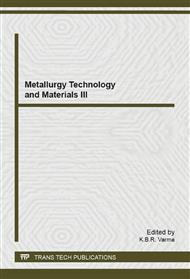p.72
p.76
p.80
p.84
p.88
p.92
p.96
p.101
p.105
Controlled Synthesis of α-Al2O3 of Different Shapes via the Hydrothermal-Pyrolysis Method
Abstract:
Taking aluminum sulfate and urea as the raw materials produce α-Al2O3 in different shapes by employing the hydrothermal-pyrolysis method. The study analyzes the characterization of the products by XRD and SEM, and explores the effects exerted by factors like time span of the hydrothermal reaction and additives such as PEG on the products’ morphology. The results indicate as follows: after 6 hours’ hydrothermal reaction in the 120°C water, with the aluminum sulfate and urea as the raw materials, spherical α-Al2O3 can be obtained through calcination at 1200°C. In the same condition but taking PEG 2000 as additives, tabular-shaped α-Al2O3 can be produced respectively by controlling the reaction time. This paper explores the formulation mechanism of α-Al2O3 in different shapes and the result shows that the growing environment of the crystal nucleus plays a vital role in the formation of the α-Al2O3’s shape.
Info:
Periodical:
Pages:
88-91
Citation:
Online since:
June 2014
Authors:
Keywords:
Price:
Сopyright:
© 2014 Trans Tech Publications Ltd. All Rights Reserved
Share:
Citation:


